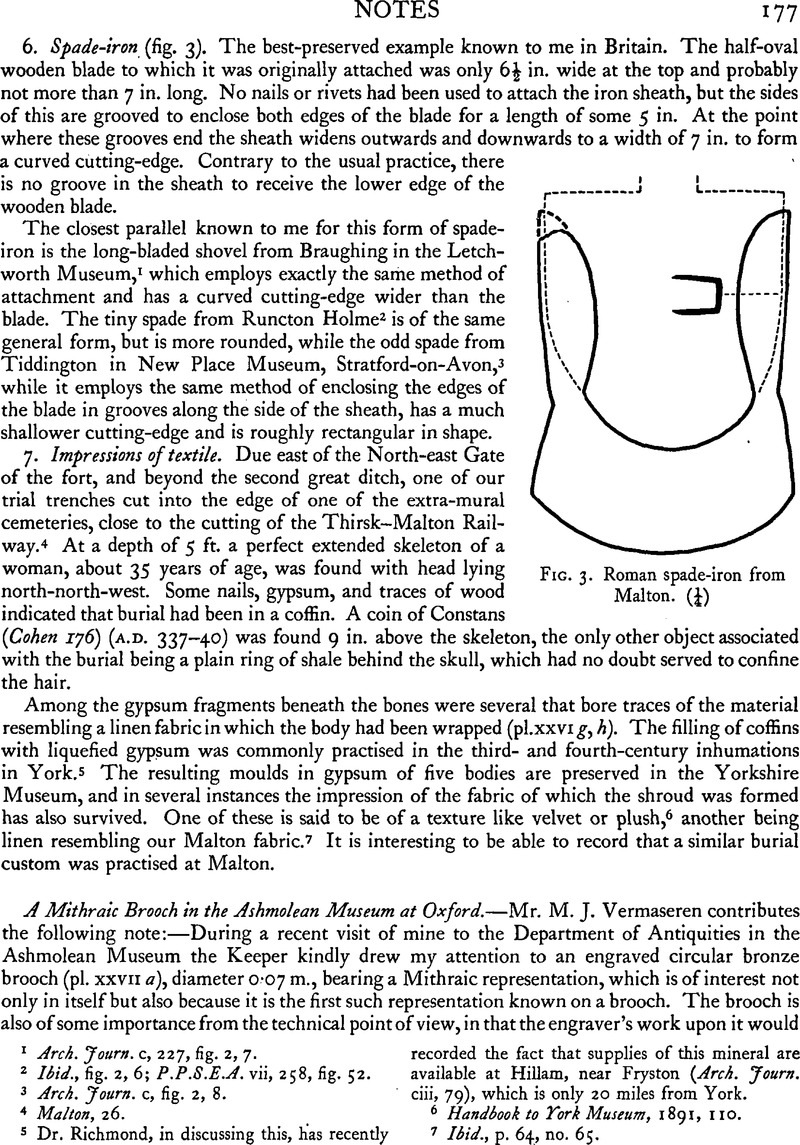Published online by Cambridge University Press: 08 January 2012

page 178 note 1 No less than 14 Mithraea have been found at Ostia (F. Cumont, C.R.A.I. 1945, 411 ff.). For Mithraic monuments from the town see id., Textes et monuments figurés relatifs aux Mystères de Mithra (Brussels, 1896–9Google Scholar, cited as MMM.) and the smaller edition of the same work with addenda, Die Mysterien des Mithra (3rd ed., Leipzig, Berlin, 1923)Google Scholar, of which an English translation from the 2nd French edition by T. J. McCormack was published in 1903. For other recent finds cf. Paschetto, L., ‘Ostia Colonia Romana’, Atti Acc. Pont. Arch, X (1912), 384ff.Google Scholar (=Bilychnis, i (1912), 463 ff.). An up-to-date list is forthcoming shortly in a Corpus Inscriptionum et Monumentorum Religionis Mithriacae by M. J. Vermaseren:
page 178 note 2 Sol is often represented on monuments to Mithras and other deities with a nimbus and wreath of 7 rays (e.g. Malakhbel-Cumont, , Syria (1928), 103Google Scholar; hence the epithet ἑπτάκτις) but he also appears with one of 6, 9, or 12 rays (cf. MMM. i, 123, notes 5–7 and 193, note 3). Representations of Mithras himself with nimbus and wreath are fewer but occur with 5 rays on a gem (MMM. ii, 447, no. 1, fig. 393), with 6 rays on reliefs from Pisignano (Ducati, P. in Felix Ravenna, V (1912), 191 ff.Google Scholar, pl. 15) and Macerata (Hülsen, C. in Rhein. Mus. 1904, 153Google Scholar and Greifenhagen, A. in Arch. Anz.1933, 443 f.Google Scholar, fig. 24), and with 9 rays on a fresco from the Casa di Tito at Rome (G. Turnbull, Treatise of Ancient Painting (London, 1740), pl. 9, and Reinach, Rép. peint. 29, 2).
page 178 note 3 Generally, especially on the Danube reliefs, the bull bears one band (e.g. MMM. ii, nos. 14, 106, 139, 158, 163, 191–3, figs. 24, 99, 129, 143, 146, 166–9, etc.).
page 178 note 4 The bull's tail normally has 3 tufts, more rarely 5 or 1. For other examples of a single tuft cf. MMM. ii, no. 16, fig. 26; Saxl, Mithras, fig. 85, 90; Colini, A. M. in B.C.R. LIX (1931), 123 ff.Google Scholar; Buren, A. W. Van, Ancient Rome as revealed by Recent Discoveries (London, 1936), p. 143Google Scholar and pl. 8, fig. 2; and C. Pietrangeli in B.C.R. 1940, 166, no. 1, fig. 13.
page 178 note 5 A Mithras group signed by the Athenian sculptor Kritoon (who seems to have lived in the first half of the 2nd cent, a.d.), found at Ostia in 1938, shows the same victorious attitude (cf. Calza, , Le Arti, XVII (1939), 389Google Scholar; B.C.R. 1938, 307; Van Buren in A.J.A. 1939, 513, fig. 5; A. Becatti in Rivista dell' 1st. Arch. Storia dell' Arte, vii, 88, fig. 59; H. Fuhrmann in Arch. Anz. 1940, 128 ff., fig. 17; Cumont, C.R.A.I. 1945, 412, fig. 2). Compare also a monument from Kerch, MMM. ii, no. 5, fig. 17, the remarkable monument from Isbarta (Cumont,C.R.A.I., 1947, 303 ff. with fig. I), and a small marble relief from the Balkans (height 0.20 m., length 0.26 m.) formerly in the Froehner collection and since 1926 in the Cabinet des Médailles in Paris, but on this one the dagger remains in the wound.
page 178 note 6 Cf. MMM. ii, no. 54, fig. 51.
page 178 note 7 Cf. Bidez-Cumont, Les Mages helléniques, ii, 75, n. 11.
page 178 note 8 Pausanias, v, 25, 9.
page 178 note 9 Cf. MMM. i, 210; id. ii, nos. 21 b, 44, 84 d, and 295 b, figs. 33, 48, and 347 at Ostia.
page 179 note 1 For example, in a fresco in the new Mithraeum of St. Prisca in Rome, Ferrua, A. in B.C.R. 1940, 59Google Scholar ff., fig. 9.
page 179 note 2 Cf. MMM. i, 69, note 2.
page 179 note 3 Cf. P.-W. s.vv. ‘luscinia’, ‘Philomela’; Roscher, Myth. Lex., s.v. ‘Aedon’, ‘Philomela’; Keller, O., Die antike Tierwelt (Leipzig, 1913)Google Scholar, i, 73; Schmidt, G., De luscinia quae apud Homerum, Sophoclem, Aristophanem est (St. Petersburg, 1904).Google Scholar The nightingale's sleeplessness is also attributed to her sadness (cf. Hesychius, s.v. ἀηδόνειος and Aelian, Varia Hist, xii, 20). This explains the reason for Varro's etymology (De Lingua Latina, v, 76) ‘lusciniola, quod luctuose canere existimatur’, though some modern scholars prefer to derive it from lusci-cinia, ‘singing during the twilight’, cf. Walde, A., Lateinisches etymologisches Wörterbuch (3rd. ed., ed. Hofmann, J. B., 1938)Google Scholar, i, s.v. ‘luscinia’.
page 179 note 4 Cf. Virgil, Georg. iv, 514 f.: flet noctem, ramoque sedens miserabile carmen integrat et maestis late loca questibus implet. The same idea occurs in later poets.
page 179 note 5 On Mithras reliefs the raven also occurs in the same attitude on the bull's tail (e.g. MMM. ii, no. 79, fig. 67); and another small bird (perhaps a nightingale) on a relief from Rome (Mus. Torlonia; MMM. ii, no. 8, fig. 20).